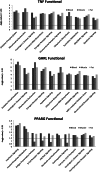Integrating genomic analysis with the genetic basis of gene expression: preliminary evidence of the identification of causal genes for cardiovascular and metabolic traits related to nutrition in Mexicans
- PMID: 22797999
- PMCID: PMC3649732
- DOI: 10.3945/an.112.001925
Integrating genomic analysis with the genetic basis of gene expression: preliminary evidence of the identification of causal genes for cardiovascular and metabolic traits related to nutrition in Mexicans
Abstract
Whole-transcriptome expression profiling provides novel phenotypes for analysis of complex traits. Gene expression measurements reflect quantitative variation in transcript-specific messenger RNA levels and represent phenotypes lying close to the action of genes. Understanding the genetic basis of gene expression will provide insight into the processes that connect genotype to clinically significant traits representing a central tenet of system biology. Synchronous in vivo expression profiles of lymphocytes, muscle, and subcutaneous fat were obtained from healthy Mexican men. Most genes were expressed at detectable levels in multiple tissues, and RNA levels were correlated between tissue types. A subset of transcripts with high reliability of expression across tissues (estimated by intraclass correlation coefficients) was enriched for cis-regulated genes, suggesting that proximal sequence variants may influence expression similarly in different cellular environments. This integrative global gene expression profiling approach is proving extremely useful for identifying genes and pathways that contribute to complex clinical traits. Clearly, the coincidence of clinical trait quantitative trait loci and expression quantitative trait loci can help in the prioritization of positional candidate genes. Such data will be crucial for the formal integration of positional and transcriptomic information characterized as genetical genomics.
Conflict of interest statement
Author disclosures: R. A. Bastarrachea, E. C. Gallegos-Cabriales, E. J. Nava-González, K. Haack, V. Saroja Voruganti, J. Charlesworth, H. A. Laviada-Molina, R. A. Veloz-Garza, V. M. Cardenas-Villarreal, S. B. Valdovinos-Chavez, P. Gomez-Aguilar, G. Meléndez, J. C. López-Alvarenga, H. H. H. Göring, S. A. Cole, J. Blangero, A. G. Comuzzie, J. W. Kent, Jr., no conflicts of interest.
Figures




References
-
- Jansen RC, Nap JP. Genetical genomics: the added value from segregation. Trends Genet. 2001;17:388–91 - PubMed
-
- Curran JE, Johnson MP, Göring HHH, Dyer TD, Rainwater DL, Cole SA, Mahaney MC, Jowett JBM, MacCluer JW, Collier GR, et al. Genetic analysis of transcriptional profiles for the identification of genes influencing common complex diseases. HUGO’s 11th Genome Meeting, Helsinki, Finland, p33 (A72). 2006.
-
- Curran JE, Johnson MP, Göring HHH, Dyer TD, Stern MP, Cole SA, Comuzzie AG, Jowett JBM, MacCluer JW, Collier GR, et al. Genetic analysis of transcriptional profiles for the identification of genes influencing risk of diabetes. 66th Scientific Sessions of the American Diabetes Association. Washington DC. June 9–13, Late Breaking Abstracts, p. 7 (A25-LB). 2006.
-
- Curran JE, Johnson MP, Charlesworth JC, Goring HHH, Dyer TD, Comuzzie AG, Cole SA, Mahaney MC, Jowett JBM, MacCluer JW, et al. Large scale transcriptional profiling for the identification of genes influencing obesity. Int J Obes. 2007;31: Suppl 1:S20
-
- Mitchell BD, Kammerer CM, Blangero J, Mahaney MC, Rainwater DL, Dyke B, Hixson JE, Henkel RD, Sharp RM, Comuzzie AG, et al. Genetic and environmental contributions to cardiovascular risk factors in Mexican Americans. The San Antonio Family Heart Study. Circulation. 1996;94:2159–70 - PubMed
Publication types
MeSH terms
Substances
Grants and funding
LinkOut - more resources
Full Text Sources

